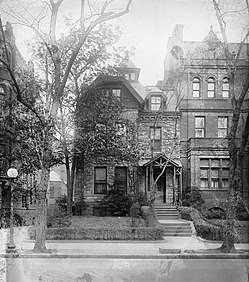Little Green House on K Street
| Little Green House on K Street | |
|---|---|
 1625 K Street in the early 1920s | |
 | |
| General information | |
| Address | 1625 K Street, NW |
| Town or city | Washington, DC |
| Country | United States |
| Completed | 1880 |
| Demolished | 1941 |
The Little Green House on K Street was a residence at 1625 K Street, NW, in Washington, DC, USA, that served as the unofficial headquarters of the Ohio Gang during the Presidential Administration of Warren G. Harding.[1] The name itself entered the American lexicon as a symbol of political corruption.[2] The Chicago Tribune described the home as one of "the symbols of a nation's disgrace".[3] The house was the site of the planning for what became known as the Teapot Dome scandal.[4][5]
History
The house was constructed by J. B. Edmonds of Iowa, a retired attorney, in 1880 for US$17,000 ($536,700 today).
During the early 1920s, it was rented by associates of Attorney General Harry Daugherty, including Jess Smith and Howard Mannington, and served as the location for numerous Presidential poker parties.[6] Many of the corrupt deals of Harding's associates were allegedly hatched there, according to testimony before the Senate Committee investigating the Teapot Dome scandal.[7]
The building was razed in 1941 to make way for the 12-story Commonwealth Building.[8]
Legacy
The house became synonymous with political cronyism. In 1934, Congressman Fred Britten, a Republican of Illinois, famously compared the Red House on R Street in Georgetown, where the original New Dealers strategized during the early years of the Franklin D. Roosevelt Administration, to the Little Green House on K Street.[9][10] The R Street address became known as the Brain Trust's Little Green House on K Street.[10][11][12]
During the scandal involving the extramarital affairs of Senator John Ensign and Congressman Chip Pickering in 2009, commentators frequently compared their C Street homes to the Little Green House on K Street.[13][14]
References
- ^ "Mannington is Mystery Man in Mystery House," Chicago Daily Tribune, March 23, 1924
- ^ "The Little Green House Loses Its Secretiveness", The New York Times, September 2, 1931
- ^ What Sacrifice, Mr. Willkie? Chicago Tribune, Oct 1, 1940
- ^ Davis, Hilda Emery; and Davis, Garry. "Letters to World Citizens", p. 50. World Government House, 2004. ISBN 0-9706483-7-5. Accessed October 12, 2009.
- ^ McCartney, Laton. "The Teapot Dome Scandal: How Big Oil Bought the Harding White House and Tried to Steal the Country", p. 72. Random House, 2009. ISBN 0-8129-7337-2. Accessed October 12, 2009.
- ^ Wolcott Gibbs, Comment, The New Yorker, October 12, 1940
- ^ New Light Shed on Deals of New York Liquor Rings, Los Angeles Times, March 22, 1924
- ^ Boese, Kent. "Lost Washington: The Little Green House" Archived 2010-06-16 at the Wayback Machine, Greater Greater Washington. Accessed October 12, 2009.
- ^ "Britten Names Hideaway of Brain Trust," Chicago Daily Tribune, August 21, 1934
- ^ a b "New Deal Run In 'Little Red House' Is Charge Hurled On House Floor" Hartford Courant, August 21, 1934
- ^ Moore, William. Mrs. Roosevelt in R Street House? Chicago Daily Tribune, May 8, 1943
- ^ Knox Explains Dinner at Mystery House, Chicago Tribune, May 4, 1943
- ^ Cal Thomas, Faithful Fellowship on C Street, The Washington Post, June 26, 2009
- ^ Jacob M. Appel, Hate the Husband? Sue the Mistress, October 6, 2009
Further reading
- Dean, John W. Warren G. Harding (The American Presidents Series). Times Books, Henry Holt and Company, LLC, 2004
- Downes Randolph C. The Rise of Warren Gamaliel Harding, 1865–1920. Ohio University Press, 1970
- Ferrell, Robert H. The Strange Deaths of Warren G. Harding, Columbia:MO, University of Missouri Press, 1998
- Murray Robert K. The Harding Era 1921-1923: Warren G. Harding and his Administration. University of Minnesota Press, 1969
- Russell, Francis (1968). The Shadow of Blooming Grove: Warren G. Harding and His Times. New York: McGraw-Hill. pp. 39–40, 403–405. ISBN 0-07-054338-0.
- Sinclair, Andrew. The Available Man: The Life behind the Masks of Warren Gamaliel Harding 1965 online full-scale biography
